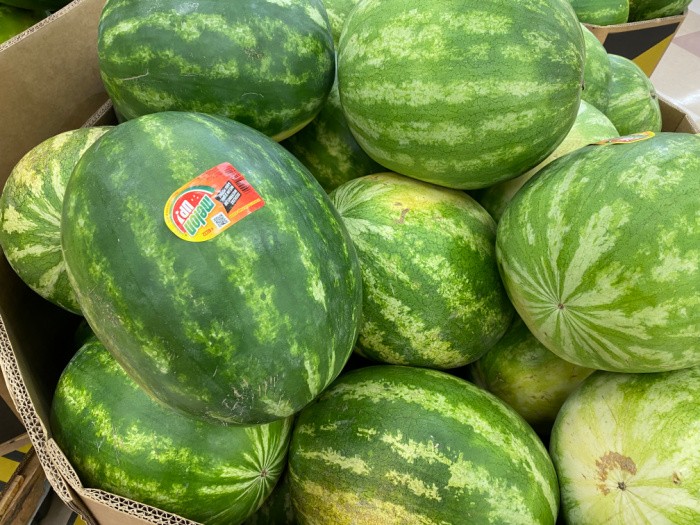
Have you wondered how to tell if a watermelon is sweet? Do you enjoy eating watermelon but hate it when it’s too watery or hasn’t matured enough to be sweet? Some watermelons are flavorful, while others taste more like water than anything else. Mark has been our watermelon “tester” for years. He’ll tell you that when you tap your knuckles on the outside of the melon, you want to hear a hollow sound. Move on to another one if it sounds “dull” without the hollow sound.
I’m not sure that’s a foolproof approach or that you’ll find a perfect melon. But if you’d like to take most of the guesswork out of finding a ripe watermelon that’s sweet and satisfies your craving for fresh and delicious fruit, check out these helpful tips. You can use these tips to tell whether a watermelon is a ripe melon and will taste sweet most of the time. In case you missed this post, How To Dehydrate Watermelon
How to Tell If a Watermelon Is Sweet
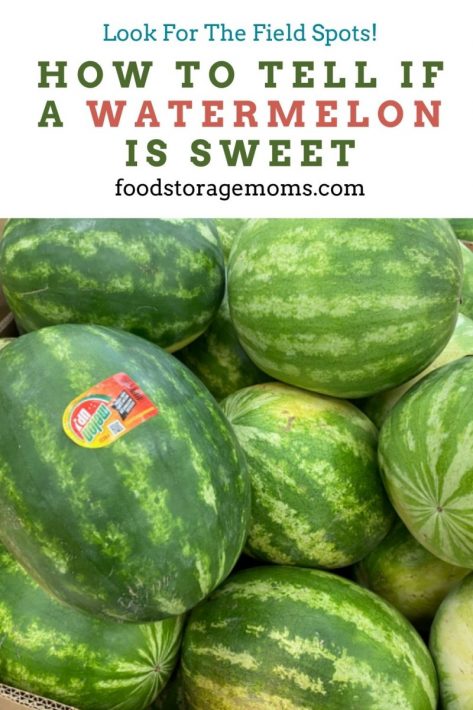
Check the Size and Weight
Check the size of the watermelon and compare it with others, whether in your garden, at the grocery store, or a farmer’s market. Some people assume a giant or heavier melon is the best, but that isn’t necessarily true.
Realistically, a heavy watermelon often has a higher water content than smaller ones, meaning they won’t taste nearly as sweet. In this case, bigger isn’t better and may indicate the melon is overripe. A smaller and lighter melon may not have reached its peak ripeness. Instead, look for an average-sized watermelon to buy. You don’t want an oversized or too-small watermelon. Instead, the goal is to find that average or medium size.
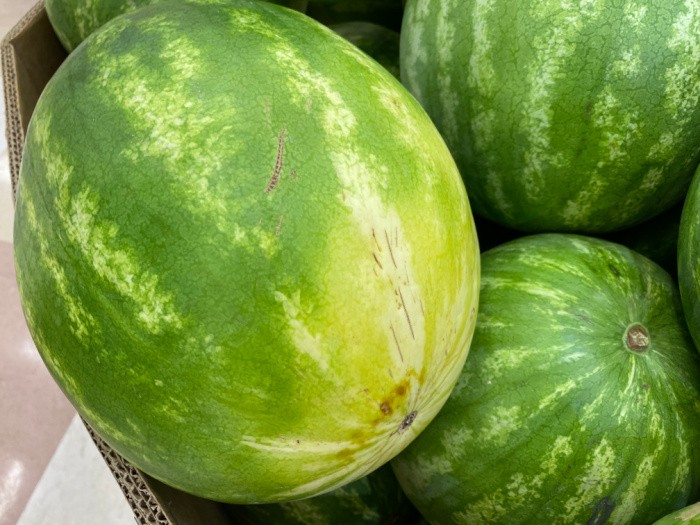
Check the Shape of the Watermelon
Carefully look at the shape of the watermelon. While the fruit is typically round, some are more elliptical than others. If you see oblong or oval watermelons, don’t bother getting them because they’re likely less sweet because they contain more water.
When you’re craving the sweetness of this fresh fruit, choose a round watermelon. If you spot the perfect round watermelon, it’s the one to buy!
Look for a Field Spot
Always check for a field spot, or ground spot, on your watermelons before you buy them. Not all watermelons will have this spot, but if you can find some that do, they can provide you with more valuable information on the fruit. Read on below.
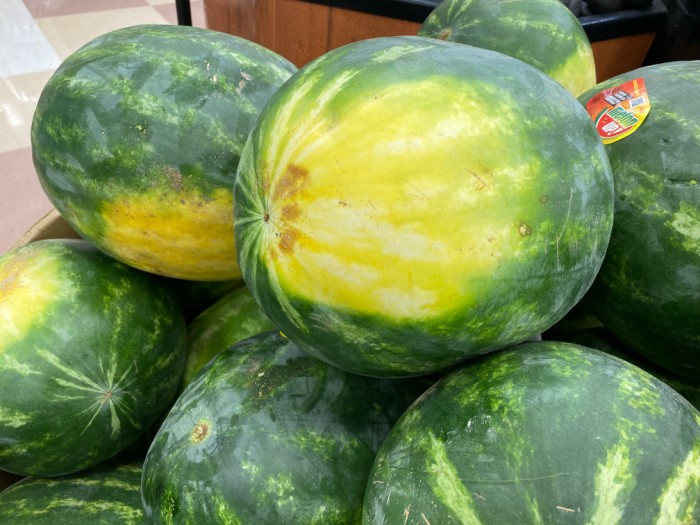
What is the field spot?
The field spot you want is a large yellow spot in an area outside the rind that appears on a watermelon and shows where it’s spent most of its time resting. Some watermelons won’t have this spot. On the other hand, some will have a slightly orange spot, and others will have a white field spot. Knowing the difference between the colors of these spots is a must. Look for the yellow belly or field spot for the best chance at prime ripeness.
Stay clear of any melons with a brown or black spot on the bottom. It is a sign the melon has belly rot which is caused by a fungus.
What does the orange spot mean?
If you find a watermelon with the orange field spot, it’s a better sign than white. The fruit is likely as sweet and flavorful as the yellow spots because it stays on the vine longer, giving it time to ripen and taste better.
If the melon is dark green on all sides of the melon it hasn’t had time to ripen. Note that watermelon doesn’t ripen well once it’s been picked. That isn’t the case with cantaloupe, they’ll continue to ripen over time.
What does the white spot mean?
When you see white specks or white spots on the watermelon, don’t bother buying it. The spot typically signifies that the watermelon spent more time on the ground and likely tastes more watery than sweet.
Be sure to look closely at any spots that you might see on the watermelon. Sometimes, the orange spot looks more yellow than orange. As long as it’s not white, you’re good to go.
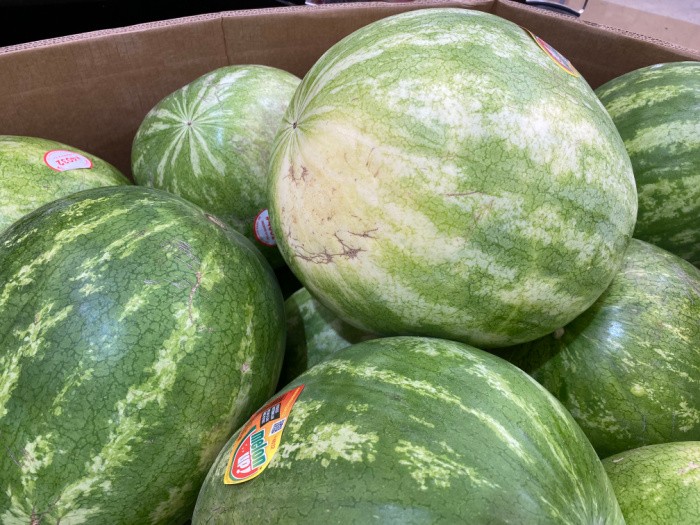
Examine the Exterior Color
While looking at a selection of watermelons, check out the exterior color of each one that catches your eye. Naturally, you’ll need to look for darker watermelons. The bright colors might catch your attention first, but those watermelons often taste more watery than sweet since they’re more likely overripe.
You may have heard the old saying, “The darker the berry, the sweeter the fruit.” It applies to watermelon as well. If the outside of the watermelon has a darker, duller appearance, it’s likely already ripe, sweet, and ready for you to eat.
Also, check the texture of the melon’s flesh. If the outer rind has soft spots it could mean the melon is overripe or wasn’t properly nourished during the growing process.
Pay Attention to Any Shininess
Have you ever noticed that some watermelons have a shiny appearance on their skin? The shininess often makes people believe these are the best watermelons to get, but that isn’t the case. Unfortunately, if you see a shiny melon in the batch when shopping for fruit, that fruit isn’t fully ripe.
They won’t have the sweetness of a watermelon that’s more dull in color if you buy them. If one store only has shiny-skin watermelons, don’t buy the fruit there. You can head to a different grocery store or farmer’s market to find what you want.
Gently Shake the Watermelon at the Store
It sounds silly, but shaking the watermelon at the store can help you decide whether to buy it. Please don’t shake it too rough to cause damage to the watermelon. Instead, hold the watermelon with both hands and gently shake it from one side to the next.
Sometimes, the size of the watermelon causes you to hear the water. If you can listen to the extra water, you’ll want to avoid that watermelon because it won’t have the naturally sweet taste you crave from the fruit.
Look for Webbing on Your Watermelon
Don’t forget to look for any signs of webbing on your watermelon. While this isn’t something you’ll see on every single watermelon you find, it’s a noticeable pattern worth paying attention to.
If you see slight webbing on different parts of a watermelon, the best thing to do is avoid buying it because it will have a watery, bland taste. If you see extensive webbing on the watermelon, buying it is a good idea. Watermelon with more oversized webbing tends to have a sweeter taste.
Perform a Thump or Sound Test
You can find a ripe watermelon when you thump the rind and it has a deep sound. When using the tapping technique, the deeper sound means the flesh has the texture you want without too much water. If the melon still needs time to ripen then the sound will be higher-pitched, whereas an overripe melon will have a thud sound or flat sound when you tap it with your knuckles.
Perform the Smell Test
It may seem strange, but you can test if the melon is ripe by smelling the aroma of the melon through the rind. If you don’t smell a sweet aroma, the melon is likely underripe, if the smell is very strong, the melon is past it’s prime and overripe.
What does the tendril look like?
A watermelon has what’s called a tendril. It is where the melon connected to the vine as it was growing and it has a curly shape. If the tendril is still green in color the melon was picked too soon. A dried-out tendril indicates the melon was ripe when picked and should be sweet tasting.
Canning Books I recommend: USDA Canning Guide or the Ball Canning Guide
Are there any health benefits from eating watermelon?
We all love eating the flesh, as in bright red flesh, of sweet watermelon. It tends to be a favorite cool summer treat for most of us on a hot summer day. I wonder how many of us consider the health benefits of this delicious fruit. Let’s jump in and check off a few things that will make this fruit even more attractive to eat.
Watermelon Is Full of Nutrients
You can feel good about eating watermelon since common nutrition facts show the flesh and watermelon juice are good sources of the nutrients we need. You can benefit from potassium, magnesium, vitamin A, vitamin C, and vitamin B6. There is also the amino acid citrulline, and many antioxidants like carotenoids, lycopene, and cucurbitacin, which make up the food chemistry in watermelon.
The antioxidants help to fight the free radicals, which can prove harmful and cause inflammation and related muscle soreness.
Watermelon Is Low in Calories
Although watermelon is pretty sweet, it is relatively low in calories—only 46 for a one-cup serving. Due to its high water content, watermelon doesn’t have much dietary fiber.
Aids Hydration
Yes, water is about 92% water, so if you eat watermelon, you’re adding to the hydration you need to support all your body functions. That includes organ operation, nutrient delivery, proper temperature regulation, digestion, and heart health.
The high water content and low daily value of sodium (like salt) found in watermelon make for a good combination for preventing high blood pressure (hypertension). That means you’re lowering the incidence of heart disease, and helping with weight loss as part of a daily weight management plan.
May Have Some Anticancer Benefits
Some studies, although not conclusive, have found that plant compounds in watermelon may have anticancer benefits. Those compounds include lycopene and cucurbitacin, as mentioned above.
Watermelon Prompts Good Heart Health
Athletes should be happy to hear that watermelon may lower the risk of heart attack and stroke by reducing cholesterol levels. As mentioned, watermelon is a good source of vitamins A, C, and B6; others also help support good heart health.
It Can Reduce Pain From Inflammation
Since watermelons contain a great combination of antioxidants and vitamins, eating watermelon may reduce the incidence of inflammation and the related oxidative damage other foods may cause. Pain is often the first sign of inflammation, so if you’re feeling muscle pain, try some watermelon to see if you get some relief.
May Help Prevent the Common Age-related Diseases, Macular Degeneration
Some studies have shown that the lycopene found in watermelon MAY, through its antioxidant and anti-inflammatory properties, help prevent macular degeneration in adults. Watermelon isn’t a substitute for professional care, so see your doctor if you have any vision issues.
Final Word
If you love watermelon but are tired of eating the watery ones that don’t taste sweet or have much flavor, use these simple tips to your advantage. You’ll need to carefully inspect your watermelon to check its size, shape, and other features it may have.
These features are essential to consider because they signify whether the fruit will taste sweet. Reviewing the watermelons carefully can take time, but it’s worth ensuring that you get what you want. Now that you know how to tell if a watermelon is sweet, you can make sure you’re always getting the most flavorful fruit at any store.
Maybe you use other methods to find that particular sweet-tasting watermelon. If so, please let me know so I can pass on your “secret” to my readers. They’ll appreciate it. May God Bless this world, Linda.
The post How to Tell If a Watermelon Is Sweet appeared first on Food Storage Moms.
